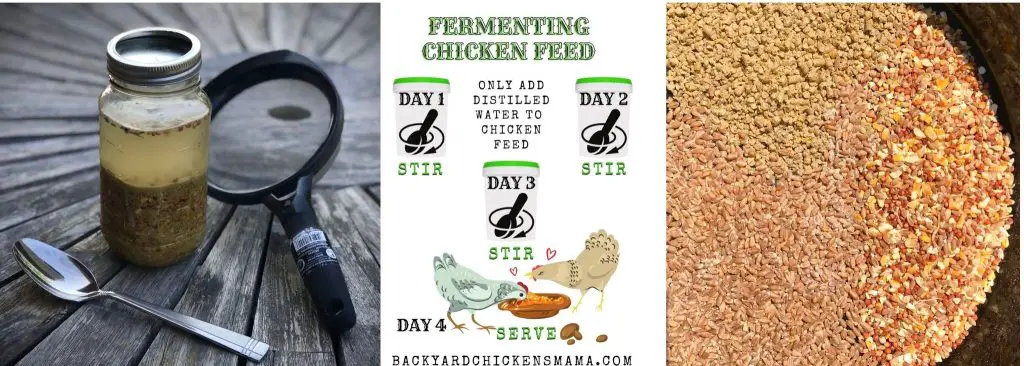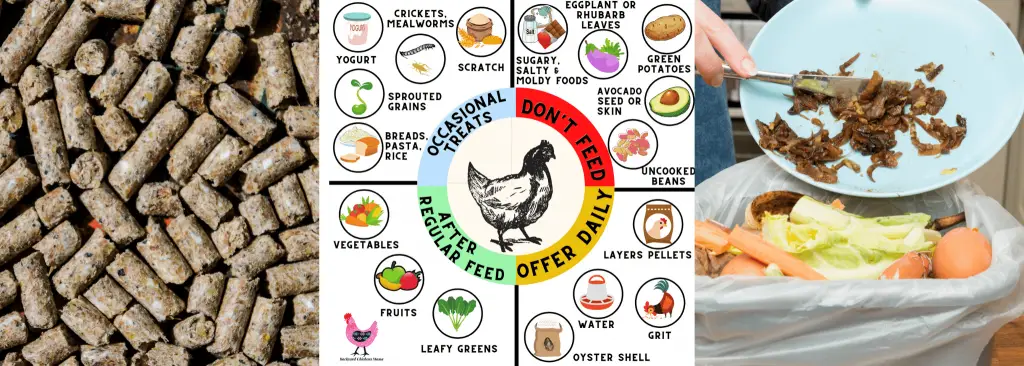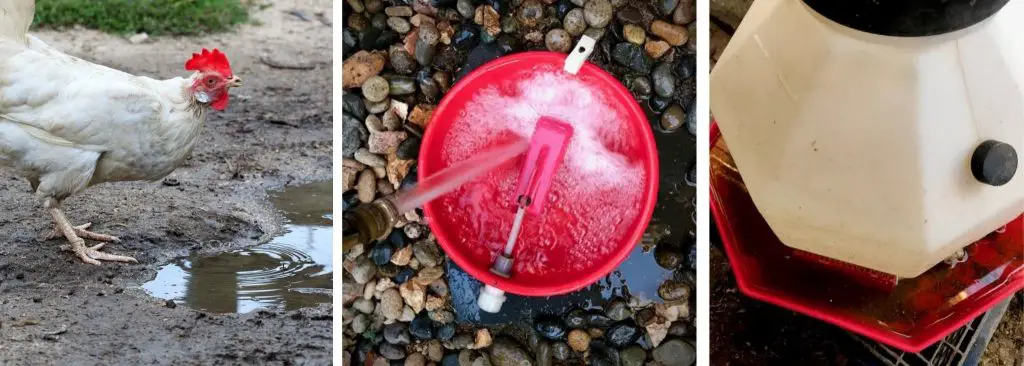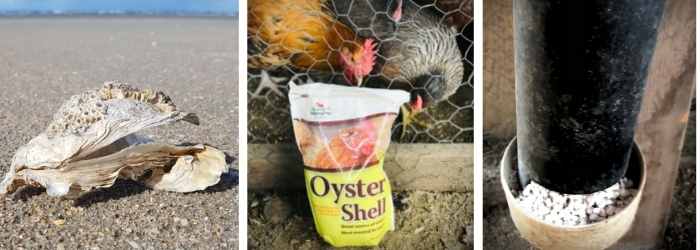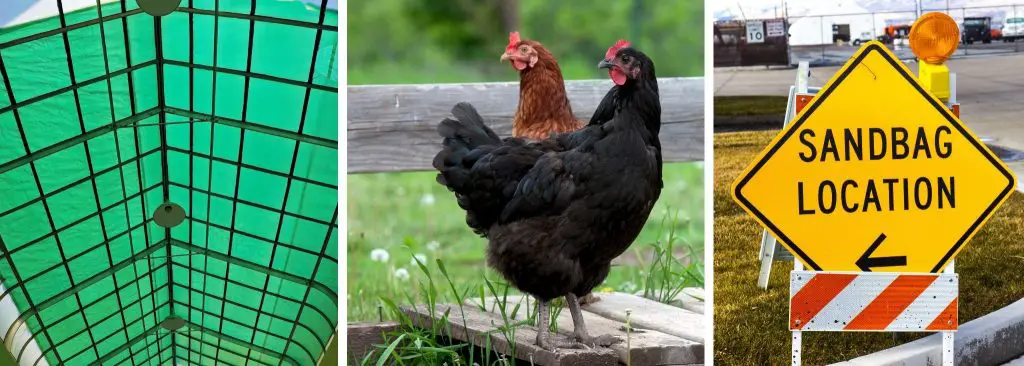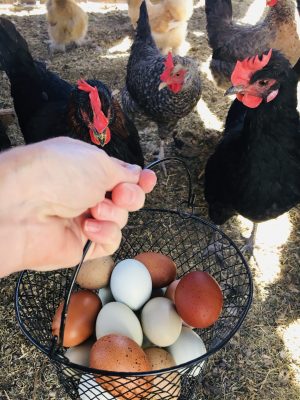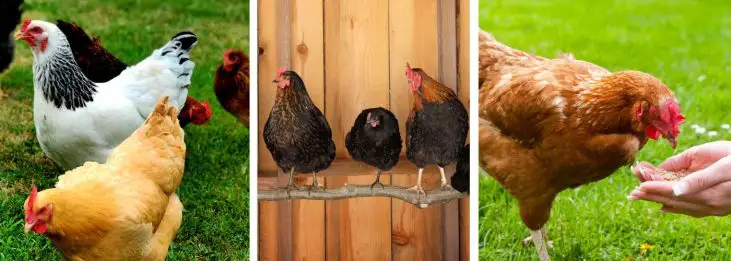
Healthy chickens are capable of living up to 10 years, if they are provided with a few simple things in their environment and diet. This article will show you specifically how to raise healthy chickens so they can live a long and happy life.
FOOD AND WATER
1. Feed Nutritionally Balanced Chicken Feed
In order to raise the healthiest chickens possible, they need to be provided with about 1/2 cup of a nutritionally balanced layers feed each day. If you choose to sprout or ferment the feed, you will notice that you will not need to feed them quite as much.
Use the Chicken Feed Calculator below to find out how much chicken feed you should be feeding your flock each day.
Chicken Feed Calculator
| Number of Chickens | Amount of Feed Needed (cups) |
|---|---|
| 0 cups |
Side Note: Bantam chicken breeds will eat a little bit less and the larger breed chickens, such as the Jersey Giant and Giant Cochins, will require a little bit more.
Types of Nutritionally Balanced Chicken Feed

- Layers Feed
- Layers feed comes in a few different forms; layers pellets, layers crumbles and layers mash.
- This contains the appropriate amount of nutrients that a laying hen needs to be healthy and thrive.
- Laying feed contains increased calcium and protein, just what laying hens need to produce healthy eggs.
- Sprouted Grains and Fodder
- By sprouting grains for chickens, it will provide up to 50% more nutrients. This will produce healthier chickens that lay healthier eggs!
- Sprouted grains become fodder when you let it grow out to 4″ in length. Chickens love these greens and they are so nutritious for them!
- Fermented Chicken Feed
- By fermenting your flocks regular feed, you can unlock hidden nutrients that they otherwise could not have benefitted from.
F.Y.I.: Because sprouted grains and fermented feed are so nutrient rich, it helps to save on your feed cost by as much as 50%.
2. Limit Chicken Treats and Table Scraps
Chicken’s love treats! After providing the appropriate amount of your flocks regular feed, it’s ok to offer them treats, in moderation.
If you are looking to raise healthy chickens, just make sure that the treats don’t constitute more than 10% of their daily diet. For an adult chicken, this comes out to about 1 TBS of “treats” each day.
Use the Chicken Table Scraps Calculator below to find out the maximum amount of treats your should be giving your chickens each day.
Chicken Table Scraps Calculator
| Number of Chickens | Maximum Amount of Table Scraps/Day (TBS) | Equivalent (Cups) |
|---|---|---|
| 0 TBS | 0 cups |
Popular Chicken Treats
- Mealworms– (Step by Step Instructions on Breeding Mealworms at Home)
- Crickets–How to Breed Crickets at Home
- Table Scraps– avoid sweet, salty, moldy and poisonous foods
- Chicken Scratch:
“Knowing when and how it is best served and the recommended quantity to give your chickens can ensure the greatest for the health and well being of your chickens.”
11 Important Things You Need to Know about Chicken Scratch
3. Provide Your Chickens Fresh, Clean Water Daily
It’s true. Chickens will drink water that is dirty, even if it is filled with their droppings and bedding. Dirty water can contain bacteria and algae and can be harmful to your chickens.
They are more likely to contract diseases such as E. coli and Salmonella through drinking dirty chicken water.
I like to add apple cider vinegar to my flocks chicken water one week out of each month. This not only is healthy for their gut, is a natural dewormer, but it also helps to keep algae growth down!
Use the Apple Cider Vinegar to Water Calculator below to see how much Apple Cider Vinegar to add to your size chicken waterer.
Apple Cider Vinegar to Water Calculator
| Size of Chicken Waterer in Quarts (4 qts=1 gallon) |
ACV Needed (Tablespoons) |
|---|---|
| 0 |
Provide your chickens with fresh, clean water on a daily basis. It is much better for their health. They instinctively know this and will drink more of it!
Use the Chicken Daily Water Needs Calculator below to see how much water you need to provide your flock each day. This is a MINIMUM.
Chicken Daily Water Needs Calculator
| Number of Chickens | Water Needed (Quarts) | Water Needed (Gallons) | Water Needed in Hot Weather (Quarts) | Water Needed in Hot Weather (Gallons) |
|---|---|---|---|---|
| 0 quarts | 0 gallons | 0 quarts | 0 gallons |
Healthy Chickens Watering Tips
- Chickens should be provided with fresh, clean water on a daily basis.
- The average adult chicken will drink about 1 quart of water per day.
- During hot weather, chickens will drink up to twice the amount of water.
- During hot weather, you will need to replenish the water more frequently.
- To prevent mold and algae from forming, wash chicken waterers routinely and keep them out of the direct sun.
4. Provide Oyster Shell for Laying Hens
Laying hens actually need 4 times as much calcium in their diet! This is because the eggs that they produce require it. If extra calcium isn’t provided for them it can affect their egg laying, egg quality and lead to other health issues.
What Happens If Laying Hens Don’t Get Enough Calcium?
- Laying hens that are not provided with enough calcium will produce less eggs.
- She will produce smaller eggs.
- Lack of calcium in her diet will also lead to thinner egg shells.
- Hens with a lack of calcium can also develop rickets and soft bones.
CHICKEN COOP
5. Provide Enough Roosting Space
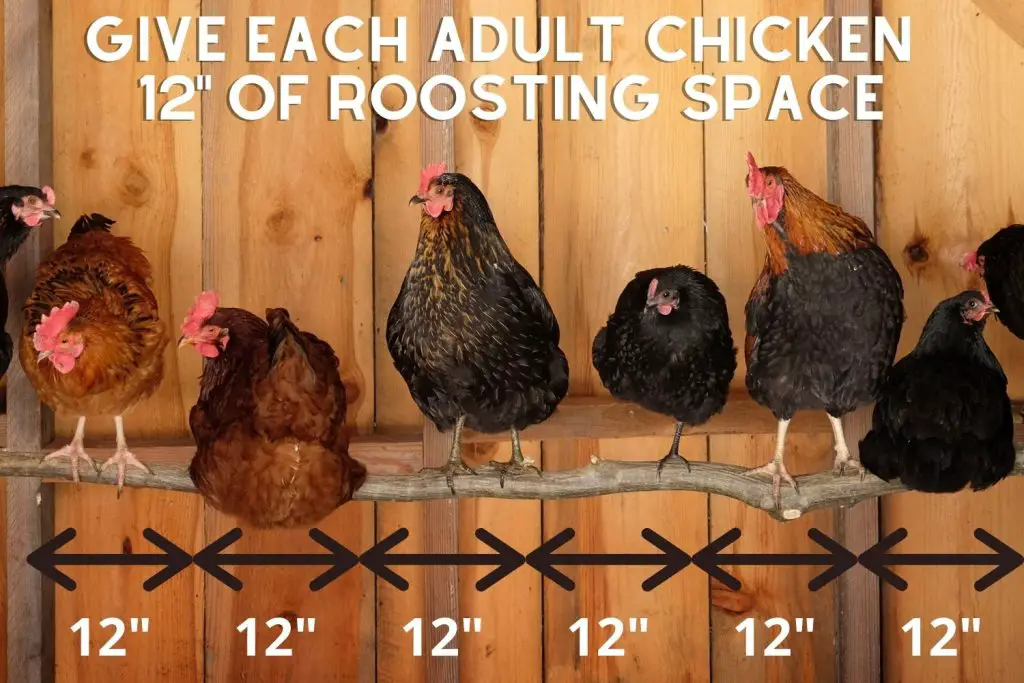
Each adult chicken requires at least 12″ of roosting space. Make sure that you provide sufficient space for your flock to roost, otherwise they will camp out on the coop floor.
Chicken coop floors are breeding grounds for bacteria and various parasites, such as mites and lice.
So, if you have 12 adult chickens, you would need 144″ of roosting space (12 feet). This can be two, 6′ long roosting bars; three, 4′ long roosting bars; four, 3′ long roosting bars.
Use the Chicken Roosting Bar Space Calculator below to see what the minimum amount of roosting space needed for your flock.
Roosting Bar Calculator
| Number of Chickens | Feet of Roosting Bars Needed |
|---|---|
| 0 ft |
How Many Roosting Bars do I Need in My Chicken Coop?
| # ADULT CHICKENS | ROOSTING BAR SPACE REGULAR BREEDS |
|---|---|
| 4 | 4 FEET- 1, 4′ BAR OR 2, 2′ BARS |
| 6 | 6 FEET- 1, 6′ BAR OR 2, 3′ BARS |
| 8 | 8 FEET- 2, 4′ BARS |
| 12 | 12 FEET- 2, 6′ BARS OR 3, 4′ BARS OR 4, 3′ BARS |
| 24 | 24 FEET- 2, 12′ BARS OR 3, 8′ BARS OR 4, 6′ BARS OR 6, 4′ BARS OR 8, 4′ BARS |
This is just a general guideline of how much roosting space the average adult chicken needs. Bantam breeds and younger chickens will require slightly less space (≅10″) and your larger breeds will require a little more space (≅14″).
6. Keep a Clean and Dry Chicken Coop
Bacteria breeds in areas that are warm and moist. A wet and dirty chicken coop, without sufficient ventilation, is the perfect place for it to flourish! This is why it is important to keep the chicken coop as clean and dry as possible.
Disadvantages of a Dirty and Wet Chicken Run
- breeding ground for bacteria and other harmful chicken diseases
- parasites and rodents love moisture
- dirty eggs
- chickens have an increased likelihood of developing bumblefoot.
Tips for Keeping a Clean and Dry Chicken Coop
- Don’t keep chicken waterers in the coop. These frequently spill and will increase the moisture level inside the coop.
- Use the deep litter method. Let your chickens turn the bedding. If the coop smells at all, it means it is time to add another 3″ of bedding material.
- Patch any roof leaks.
- Reroute any rain water that is running into coop or chicken run
7. Provide Sufficient Ventilation in the Chicken Coop
A chicken coop needs sufficient ventilation to help keep it dry. Sufficient ventilation will also stop the ammonia fumes from building up inside the coop and smelling.
The general rule of thumb is that a chicken coop needs about 1 square foot of ventilation for every 10 square feet of chicken coop floor space.
Use the Chicken Coop Ventilation Calculator to see how much ventilation is recommended for your chicken coop space.
To figure out the square footage of your chicken coop, multiply the length x the width and input this number into the calculator below.
Chicken Coop Ventilation Calculator
| Chicken Coop Area (Square Feet) | Ventilation Required (Square Feet) |
|---|---|
| 0 sq ft |
How to Figure Out How Much Ventilation is Needed for a Chicken Coop
STEP 1: Measure the length and width of your chicken coop. Let’s say your coop is 4′ wide and 10′ long.
STEP 2: Multiply the length times the width. 4′ x 10’= 40 square feet
STEP 3: A chicken coop needs 1 square foot of ventilation for every 10 square feet of coop flooring. Divide number in STEP 2 by 10 square feet. 40 square feet ÷ 10 square feet = 4 square feet.
STEP 4: 4 Square Feet of ventilation is needed for a 4′ x 10′ chicken coop.
STEP 5: 4 square feet of ventilation can be provided with any of the following set ups:
- Four 1′ x 1′ windows: Place them above the highest roosting bar, one on each side of the coop.
- Eight 6″ 1′ windows: Place them above the highest roosting bar, two on each side of the coop.
During the warm months, coops need more ventilation than during the cooler winter months. For increased ventilation on hot days, consider installing a coop screen door.
8. Keep Chicken Nesting Boxes Clean & Provide Enough for Your Laying Hens
The nesting boxes are where your hens spend quite a bit of time in. It is also a prime location for parasites such as mites and lice to wreak havoc on your hens.
Dirty nesting boxes can breed bacteria and affect the health of your entire flock.
Daily maintenance of the nesting boxes is essential for happy and healthy hens! Happy + Healthy Hens = More Eggs!
Make sure that you provide enough nesting boxes for your hens to lay. Not providing enough nesting boxes can stress your hens out and you will notice with a decline in egg laying.
Use the Chicken Nesting Box Calculator to see how many nesting boxes are recommended for your flock of laying hens.
Nesting Box Calculator
| Number of Hens | Number of Nesting Boxes Needed |
|---|---|
| 0 |
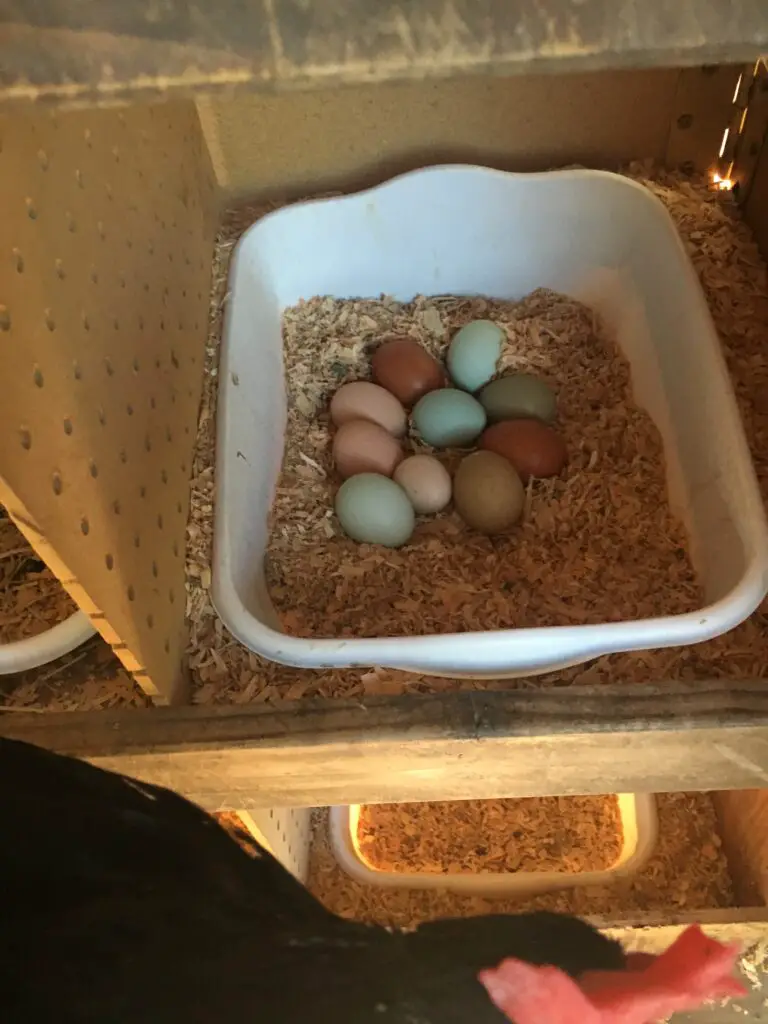
Tips for Keeping Nesting Boxes a Healthy Environment for Your Hens
- Make the nesting boxes a quiet, clean place for your hens to lay eggs.
- Remove broody hens from nesting boxes. If your goal is not to have a clutch of eggs hatch, you need to break your broody hens.
- Remove hens that sleep in the nesting boxes. Chickens do most of their pooping at night and you don’t want any chicken poop in there.
- Chicken poop and smashed eggs breed bacteria. If you see these in a box, remove the nesting material and replace it with fresh bedding.
- Sprinkle Nesting Box Herbs to:
- encourage egg laying
- kill parasites
- deter rodents
- improve your hens health
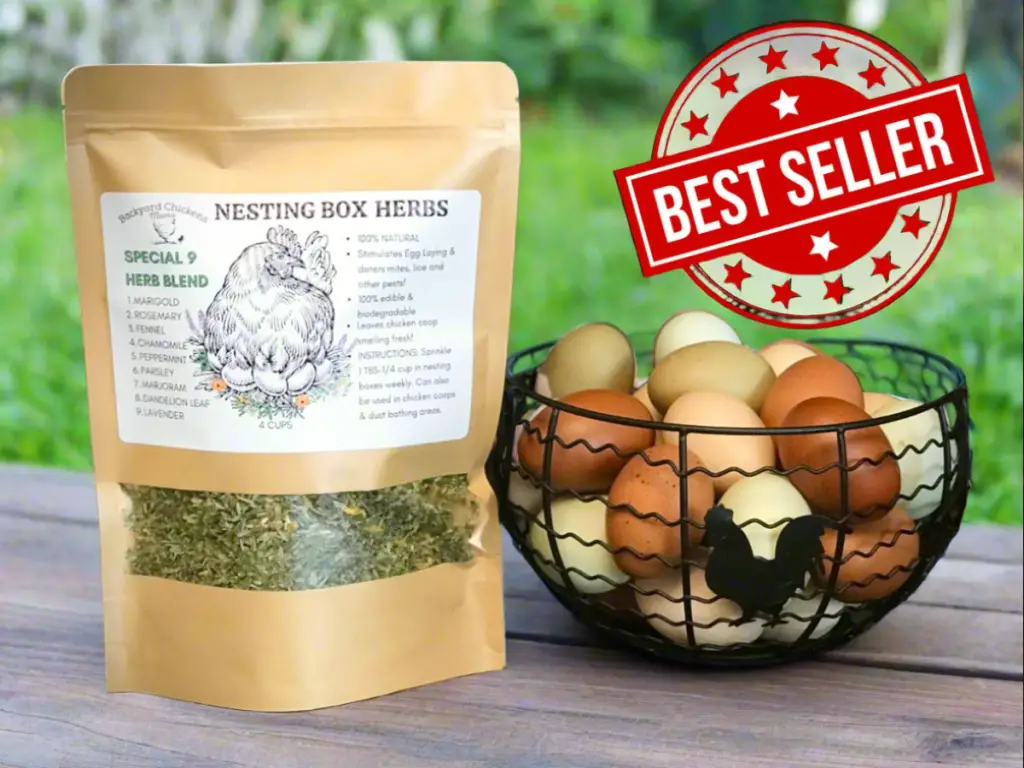
Increases egg laying naturally.
- Improves chicken health.
- Deters parasites: mites, lice, fleas & flies as well as mice, rats, raccoons, coyotes, opossums and more!
- On SALE!
- Shop: Nesting Box Herbs
CHICKEN RUN
9. Provide Sufficient Space for Your Chickens to Move Around
Chickens that live in cramped conditions are more likely to develop parasites and various diseases. It is important to provide sufficient space for your chickens to move around.
How Much Space do Chickens Need in a Chicken Coop?
Each adult chicken should have at least 2-4 square feet of chicken coop space. Younger chickens and bantam breeds require a little less space and the larger breeds can use a little bit more space.
Housing too many chickens in a small space produces piles of chicken poop, increasing the humidity level and increasing the spread of various diseases and parasites.
Crowded conditions also causes increased fighting, bullying and other behavioral issues in chickens.
Use the Chicken Coop Size Calculator to see how much space your flocks coop needs to be. Keep in mind that this is just a MINIMUM.
Chicken Coop Size Calculator
| Number of Chickens | Minimum Coop Size (Square Feet) |
|---|---|
| 0 sq ft |
So, if you have 10 regular size chickens, your coop should be a minimum of 20-40 square feet.
- 20 square feet= 5′ x 4′ coop or 10′ x 2′ coop
- 40 square feet= 4′ x 10′ coop or 5′ x 8′ coop
How Much Space do Chickens Need in a Chicken Run?
Each adult chicken requires a minimum of 8 square feet of chicken run space. This is a minimum. The more space that you can provide for them, the better.
Both younger chickens and the smaller breeds, such as bantam chickens, don’t require quite as much space. Larger breeds, such as Orpingtons and Giant Cochins should be provided with a little more space.
In order for chickens to act like chickens, they need sufficient space to peck and scratch the ground, dust bathe, forage for food, flap their wings and run around.
Use the Chicken Run Space Calculator to see how much running around space your flock needs. Keep in mind that this is a MINIMUM. More is always better.
Chicken Run Space Calculator
| Number of Chickens | Minimum Chicken Run Space (Square Feet) |
|---|---|
| 0 sq ft |
So, if you have 10 chickens, they need a minimum of 80 square feet of chicken run space.
- 80 square feet= 10′ x 8′ or 5′ x 16′
10. Provide a Dust Bathing Area
Chickens like to keep clean and the do this by taking a dust bath. You can encourage dust bathing by providing a dust bathing area for them.
Chickens will dust bathe to remove parasites, such as mites, lice and fleas. They also will dust bathe to cool down during hot weather.
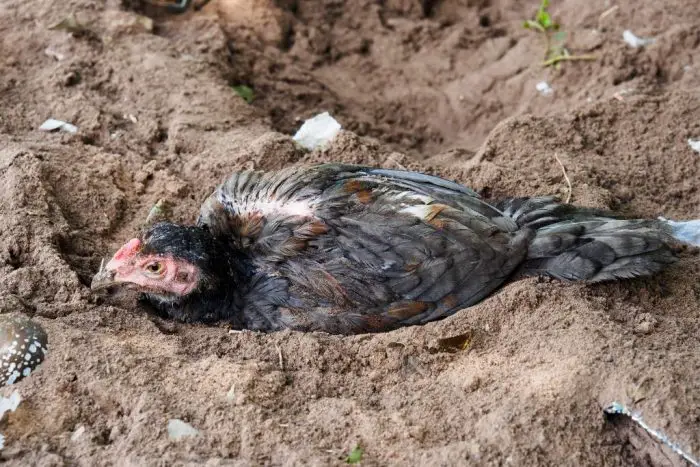
How to Make a Dust Bathing Area for Chickens
STEP 1: Get some fine dirt or sand and fill an area with it. You can use a large tractor tire or container or just dig a hole and fill it with the fine dirt and/or sand.
STEP 2: Add some herbs to the dust bathing area that will help to improve their health, deter pests and kill parasites:
- Marigolds
- Rosemary
- Fennel
- Chamomile
- Peppermint
- Parsley
- Marjoram
- Dandelion
- Lavender
STEP 3: Add diatomaceous earth and/or wood ash to the dust bathing area. This will also help to kill parasites.
STEP 4: Add fresh herbs, diatomaceous earth and wood ash weekly to the dust bathing area.
CONCLUSION: 10 Best Tips- How to Raise Healthy Chickens
So, there you have it. These are the 10 best tips for raising healthy chickens. There really is no secret to keeping chickens healthy. As long as you tend to the following 10 needs of your chickens, you are likely to have your flock live a long, happy and healthy life!
- Feed nutritionally balanced chicken feed.
- Limit chicken treats and table scraps.
- Provide fresh, clean water daily.
- Serve oyster shell, on the side, for laying hens.
- Provide enough roosting space.
- Keep the chicken coop dry and clean.
- Provide sufficient ventilation.
- Keep chicken nesting boxes clean.
- Provide enough space for your chickens both in their coop and in the chicken run
- Prepare a dust bathing area for your flock.
For more tips on how you can keep your poultry healthy, visit the CDC article, “How to Keep Backyard Poultry Healthy.”

